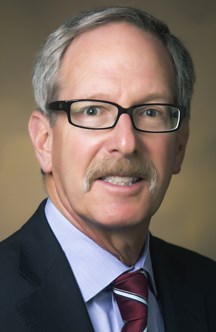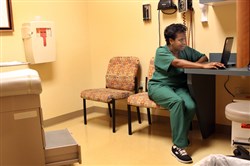VOL. 38 | NO. 37 | Friday, September 12, 2014
Unintended consequences: ER visits increase
By Sheila Burke
Hospital officials have been pushing for the state to expand Medicaid health care coverage for thousands of Tennessee’s poorest citizens, despite two significant and related concerns:
Expansion will lead to increased visits to the most expensive place in America for routine health care, the emergency room.
With expansion, there may not be enough primary care doctors to treat those newly covered patients, one of the reasons some people with non-emergency illnesses show up at the ER.
These worries come as Gov. Bill Haslam considers submitting a plan to the federal government that would expand health care coverage to thousands.
Concerns about increased trips to the emergency room follow a landmark study published earlier this year that found patients with new Medicaid benefits in Oregon wound up going to the ER far more than even those who had no health coverage at all.
And the study was followed by a survey by emergency room physicians around the country who reported increased visits to the ER since the Affordable Care act went into effect in January.
Doctors say patients often wind up going to the ER if they can’t find a primary care doctor to treat them, and primary care doctors are in short supply nationwide.
To make matters worse, physicians say, many family doctors and specialists either limit the number of Medicaid patients they see or don’t treat them at all.
“If you’re expanding access to health insurance but at the same time you’re not expanding the primary care infrastructure, then patients still need somewhere to go,” says Dr. Mark Reiter, president of the American Academy of Emergency Medicine, who also works at St. Thomas Rutherford Hospital.
Haslam has said he does not want to expand TennCare, the state’s Medicaid program. Instead, the governor wants to leverage federal money to buy private insurance that would aim to keep costs down by instituting copays in at least some circumstances.
Haslam still has to saeek the approval from the federal government and then get the Republican-led state legislature to pass it.
Even with the plan to use money for private insurance, there still could be a significant increase in TennCare patients. TennCare rolls have already increased this year by more than 55,000, state officials say.
Arkansas, which expanded health coverage for its poor by using the money for private insurance, still kept its sickest citizens on traditional Medicaid.

Becker
Doctors and hospital officials disagree on whether the plan to institute copays might actually discourage overuse of already overburdened emergency rooms. Federal law requires that people be evaluated in an emergency room regardless of ability to pay.
“I think absolutely what the governor is trying to do is to make sure there is more thought given to use of the emergency room,” says Craig Becker, president of the Tennessee Hospital Association. Still, Becker expects to see increased use of the ER if the state expands it health coverage.
“I think everybody anticipates that it’s probably going to happen once we get fully covered because there aren’t enough primary care physicians.” THA is closely monitoring border states that have expanded health coverage. So far, Becker says, ER use has not gone up significantly in the surrounding states.
Staff at both the University of Tennessee and Vanderbilt medical centers says their emergency rooms are already inundated with patients. Some are critically ill, but many are going for routine care that would be better treated at a family physician’s office or urgent care center.

Slovis
“We certainly see very high severity emergencies, and we’re at that Level 1 trauma center,” explains Dr. Corey Slovis, chairman of the Department of Emergency Medicine at Vanderbilt.
“But it continues to amaze me on a day-by-day basis how many patients use the emergency room for anything and everything – whether it be a prescription drug refill, the inability to get into see a specialist or just for routine care of minor symptomology that ought to be seen in a primary care office,” he adds.
Emergency rooms are sometimes victims of their own success, says Christian Lawson, director of the Emergency Department at the University of Tennessee Medical Center. UT’s medical center is highly ranked both nationally and regionally, and as a result it attracts patients, many of whom just want to get into the system, but would be better served at an urgent care center.
Doctors say many of the patients that come in to the ER suffer from chronic health conditions such as uncontrolled diabetes or hypertension and can’t wait weeks to get into see a doctor. Other patients may not be able to see a subspecialist like a neurosurgeon or orthopedic doctor because few take Medicaid.

Medical assistant Zaira Olivieri prepares for a patient in one of the examination rooms at the clinic at Saint Thomas Family Health Center South.
-- Michelle Morrow | The LedgerA study published in the Journal Science in January found that patients in the Portland, Oregon, area who were given new access to Medicaid made 40 percent more trips to the emergency room than people who had no health care at all. It was the first use of a randomized, controlled study that looked at the impact of expanding Medicaid.
The study began in 2008 before implementation of the Affordable Care Act, also known as Obamacare. In addition to increased trips to the ER, it found an overall increase in health care services given across the board to the new Medicaid recipients, one of the study’s authors says.
“This increase in emergency department visits is happening in the context of increased primary care, increased preventive care use and increased perceived access,” Sarah Taubman, a research scientist at the Massachusetts Institute of Technology and one of the authors of the study, says of the findings.
Supporters of the health law have argued that patients will make less costly trips to the emergency room once they get covered and get primary care.
But some say the findings point to a basic economic principle: Demand goes up for services when cost goes down.
It’s not clear how often TennCare recipients go to the emergency room since the state does not have figures showing the number of ER visits by TennCare recipients, says John Goetz, a spokesman for TennCare, via email.
Earlier this year, nearly half of the ER doctors who responded to a poll by the American College of Emergency Physicians said that they’ve seen increased emergency room visits since the Affordable Care Act went into effect Jan. 1, 2014.
“I don’t think anybody was surprised by the result of the survey,” adds Ryan Stanton, a spokesman for ACEP who is also an ER doctor in Lexington, Kentucky. “I think most of us who are ER providers predicted an increase from the very beginning knowing the mindset of the patients we see.”
Kentucky expanded its Medicaid program, and Stanton says he’s been seeing patients with new health cards. “A number of people every night I see say, ‘I just was fine. I wanted to get checked out.’ I’ve got a $250 copay. I’ve got to be pretty darn sick before I get checked out for anything.”
Kentucky officials say they are working to educate many patients, some who have health insurance for the first time, on how best to use the ER.
“Nearly three out of four of those newly insured through Kynect [Affordable Care Act for Kentucky residents] qualified for the Medicaid expansion,” Gwenda Bond, a spokeswoman for the Kentucky Cabinet Health and Family Services, says in an email.
“With hundreds of thousands of newly insured members, the delivery of services across the board increased, including ER visits, physician visits and prescriptions filled. Many of these newly insured have not had prior coverage and are still learning how to access their benefits. There is a steep learning curve to navigating the healthcare system and all providers and the insurance companies must help educate the newly insured.”
Arkansas had a very different experience so far. A preliminary survey done by the Arkansas Hospital Association found that emergency room visits in that state dropped by 2 percent in the first quarter.
“The survey wasn’t all that long or complicated,” explains Paul Cunningham, executive vice president of the Arkansas Hospital Association. “What we’re doing this time is a bit more encompassing.”
More information will be available in the coming weeks to see if the trend holds for the second quarter, he says.
Arkansas has a program similar to what Haslam apparently wants to implement.
The “private option” allowed federal money to go toward purchasing health insurance for people making between 0-138% of the Federal Poverty Level with the medical frail being put on traditional Medicaid, Kate Luck, a spokeswoman for the Arkansas Department of Human Services, says.
Arkansas requires many of its newly insured under the private option to pay a $20 copay when visiting the ER.
Haslam has said he thinks patients need to have some “skin in the game,” and many who work in hospitals agree.
“I think whatever you can put on the patient to create some ownership is imperative,” says Lawson of the UT Medical Center.
Doctors say one of the biggest problems facing the medical care in the U.S. is the chronic shortage of primary care physicians.
“The system we have in this country is sort of like the wrong care, wrong place, and wrong time,” says Reid Blackwelder, president of the American Academy of Family Physicians and professor of family medicine at the Quillen College of Medicine at East Tennessee State University.
Blackwelder says medical students aren’t going into primary care because the pay is much lower than that of other doctors. Medical school graduates with as much as $200,000 in debt don’t want to go into an area in which pay is relatively low.
Another issue primary care doctors face is low reimbursement rates from Medicaid, he says.
“It unfortunately is the payment structure in our system that emphasize procedures and subspecialty care rather than primary care,” Blackwelder says. “So when you look at the differences between how much a country pays per capita for health care in other developed countries and their outcomes, the United States pays more than any other country about two to three times as much and yet our outcomes are not very good.
“We usually rank about No. 37 when you look at all the outcomes together, and the main difference has been in the primary care physician base. Most of these other countries have usually about a 70 percent primary care physician workforce, 30 percent subspecialty, and our country is exactly the opposite.’’